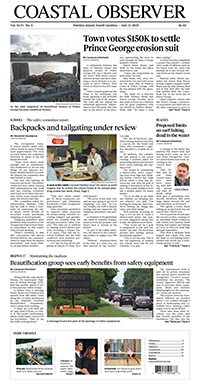Environment
Wetlands play key role as county makes plans for hazard resilience

Protecting natural resources is key to making Georgetown County able to withstand the impacts of disasters that have occurred with increasing frequency, according to consultants who are helping the county prepare a blueprint for resilience.
The county needs to “enhance natural resilience through responsible land use,” which includes protecting wetlands, reducing the amount of developed surfaces that are impervious to water and increasing green space, says the draft of the resilience element of the county’s comprehensive plan. It will be up for public review at a meeting this month.
“The wetlands in Georgetown County are integral to the health and resilience of the County as a whole,” the draft states. “Protecting estuarine and wetland environments, both fresh and saltwater, to ensure their safety for years to come would be an incredibly productive way to prevent a decline in natural resilience.”
Resilience was added to the list of elements state law requires local government to include in their comprehensive plans in 2020. Georgetown County is currently updating its plan, but in March, County Council deferred action on the natural resources element after conservation groups complained that protections recommended by the Planning Commission had been removed by county staff.
Council Member Clint Elliott, who made the motion to defer, said he wanted the natural resources element to align with the land-use element, which the county plans to adopt by the end of the year.
While the natural resource element retained some goals for wetlands protection, including adoption of a county ordinance that is stricter than state or federal regulations, the staff version struck out recommendations for a marshfront management plan and for a “green sales tax” that would be used to acquire land for open space.
The resilience element is being prepared by the St. Bernard Project, a nonprofit that specializes in disaster recovery. At a public meeting in January, the consultants explained that it was looking at both the variety of disasters – natural and man made – and the socioeconomic factors that affect the ability of residents to deal with them.
It defines resilience as the “ability to anticipate, prepare for, respond to, and recover from a disaster.” And it says that for Georgetown County those disasters are most likely to come from the effects of a changing climate and a growing population that is placing itself in harm’s way.
The draft plan notes “a slight disconnect” between government departments and other organizations about resilience. It recommends the county create the position of resilience coordinator and establish a resilience working group.
The coordinator could also serve as the manager for the federal flood insurance program that encourages tougher regulations in exchange for reducing flood insurance premiums for property owners.
That program, known as the Community Rating System, would also serve as an incentive for public awareness of resilience efforts, the draft says.
It also recommends working with the school district to help children learn about resilience practices.
The draft resilience element says the county needs to better understand the economic impact of disasters, particularly on the tourism industry.
A report presented to County Council this week by the Chamber of Commerce, which manages the county’s tourism marketing, showed that 2,900 jobs are tied to the hospitality industry and that tourist spending is nearly $320 million a year. That results in over $37 million in state and local tax collections.
The consultants at St. Bernard recommend the county look at the impact of past disasters on tourism to get a better understanding of its ability to “bounce back.”
To measure the risk from population growth, the draft recommends the county conduct Safe Growth Audits.
That process, developed in 2009 by a planning professor at the University of North Carolina, determines whether a community is guiding growth away from high-risk areas and locating critical facilities outside those areas as well as protecting ecosystems, creating knowledgeable local leaders and monitoring its progress.
b on the resilience element will be held May 25 at 5:30 p.m. in the County Council chambers.




